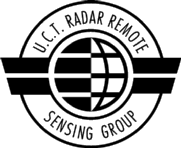

Back to list of Group's MSc Theses
Abstract:
Multiple antenna synthetic aperture radar SAR interferometry is a single pass interferometry technique for topographic mapping. A Bayesian model based approach to topographic reconstruction with multiple-antenna SAR interferometry, proposed by Dr A J Wilkinson, is implemented and analysed in this dissertation. The phase ambiguity reduction and data noise improvement achieved with multiple-antenna interferometry are explained from the basic principles of radar interferometry. The surface topography is modelled by a rectangular grid of discrete points on the ground, corresponding to the individual pixels in a SAR image. The position of each point is parameterised in terms of the angle of arrival of the received signal, represented by a pixel in the SAR image. Topographic reconstruction stated as an angle of arrival parameter estimation problem in a Bayesian inference framework.
To generate the necessary multiple-antenna data, an interferometric SAR simulator (based on a forward model for the SAR imaging process) is implemented. Two Bayesian estimation methods are implemented for estimating the angle of arrival parameter from the simulated multiple-antenna data. One estimation method uses a single pixel data vector to estimate the angle of arrival for a point in a image. The other estimation method employs a multiple pixel data vector with data from neighbouring pixels to estimate the angle of arrival for a point in the image. The likelihood and posterior distributions of angle of arrival obtained with the Bayesian estimation methods are analysed in detail for a three-antenna airborne SAR system. The ambiguities measured in the likelihood distribution of the angle of arrival obtained using the three antenna simulated dataset are verified from theoretical calculations. A measure of the accuracy of the angle of arrival estimate is formulated in terms of the standard deviation of posterior distribution obtained from the Bayesian analysis of the data. Finally, the Bayesian estimation methods are applied to a simulated three-antenna datset to demonstrate the topographic reconstruction process.
Back to list of Group's MSc Theses
Abstract:
Registration of two or more images of the same scene is an important step in image processing that seeks to extract information not obtainable from one of the images in question. This process is required in many Engineering, Scientific and Medical applications. The accuracy of this step is crucial to the reliability of subsequent image processing and or decisions made on its basis. The huge size of the data to be processed, the speed at which the processing is required and the accuracy requirements necessitates a quick, efficient, robust and in some respects automatic program which efficiently harnesses available computing resources. This is the object of this project - the design of an image registration algorithm with a bias for SAR/InSAR applications but also applicable for other registration purposes, implemented on a parallel cluster of computing nodes.
Back to list of Group's MSc Theses
Abstract:
This dissertation describes the development of a distributed data-capture and data-processing framework for use with a network-aware ground penetrating radar. The software that was developed addresses weaknesses in existing data procesing software, with the main focus being on the distributed capabilities of the framework. The framework was designed from an object oriented perspective, using the Unified Modeling Language to describe the architecture. The Java programming language was used to implement the design. The Common Object Request Booker Architecture was used as the messaging protocol, however the framework was designed such that an alternative messaging protocol such as Java Remote Method Invocation could also be added at a later stage. The Extensible Markup Language was used for storing data as well as configuration information.
The framework was designed to be modular such that additonal functionality could be added later in the form of modules. Three modules were developed, a data-viewer module, a data-persister module and a radar controller module.
Performance tests were completed to measure the maximum number of profiles that could be transmitted per second for two scenarios, one involving a stand-alone machine, and another involving two networked machines using 10 Mbit ethernet. The highest data rate of 346 was achieed when there were no viewer modules active in the system and no processing being applied. For a more useful scenario involving the inverse Fourier transform and a data viewer, it was found that the highest data rate was measured when the radar server was located on a separate machine to the processing framework. The maximum data rate measured under these circumstances was 177 profiles per second. Since the maximum data rate that the hardware can currently support is ten profiles per second, the data rate for the framework is more than sufficient.
Back to list of Group's MSc Theses
Abstract:
An interferometric synthetic aperture radar (SAR) simulator was created for the purposes of experimenting with and demonstration of the interferometric process, mission planning and radar image interpretation. The simulation method employs statistics and terrain geometry to form a synthetic image and requires inputs of a digital elevation model (DEM), flight path description, radar parameters, a terrain classification map and temporal decorrelation factors. Output images include the following images: radar cross section, power, total coherence, temporal coherence factor, geometrical coherence factor, absolute phase, interferograms and flattened interferograms.
The simulated images are compared with actual SAR images from the European Space Agency's ERS (Earth Remote Sensing) imaging satellites to which a good correlation can be seen. The simulator's strength is in portraying regions of rocky terrain and sparse to moderate vegetation, where the geometric information provided by the terrain model is the primary contributor to the image statistics. An empirically derived backscatter model and a speckle generation program were implemented to further develop more realistic greytone and texture. Upgrades to incorporate a general flight path and a model for the receiver transfer function and other future improvements are discussed.
Back to list of Group's MSc Theses
This page was last updated in January 2008 (RL)
![]()